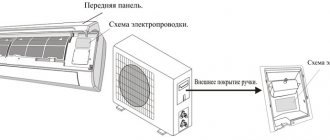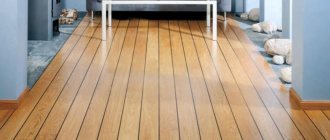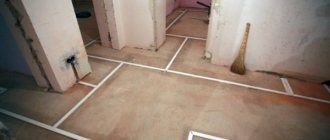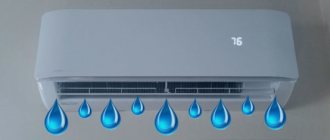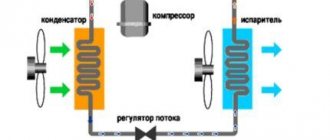It is recommended to install the split system before the painters level and paint the walls. In a large apartment or house, you may need several indoor units and one external unit, which is connected to the fan coil units by routes of pipes and wires. These communications are connected into one bundle and sealed simultaneously. After a fresh renovation, you will again have to chisel plaster, brick or concrete to hide the air conditioner route along the ceiling or walls. These are additional costs, dirt in the room and inconvenience. In addition, electrical wires are already installed in the walls and there is a risk of damaging them if you do not use special equipment that searches for wiring.
What is an air conditioner route?
Each split system consists of at least two modules, external and internal.
The number of internal modules is determined by the power of the equipment and depends on the area of the room. All modules are connected to each other by a system of pipelines that ensure the movement of refrigerant and drainage of condensate.
The piping system connecting the indoor module to the outdoor unit, as well as the cable supply line, is called the air conditioner route
In addition to the piping, all modules are connected by a cable that provides power and control. It is this cable and pipeline connecting all the modules that is called the air conditioner route.
Requirements and standards
Typically, air conditioner units are connected to each other by a copper pipe. Installation of equipment should be carried out only after carefully determining its location, since moving the device even a few centimeters will then be impossible.
The external unit should be positioned in such a way that it can be easily accessed in the event of a breakdown. If this is not possible from the apartment, then industrial climbers must reach the block. When laying a pipe, you must take into account that it should not pass at an acute angle, as it may bend, which will interfere with normal operation.
Attention! In order for the new equipment in the apartment to look aesthetically pleasing, it should be installed in such a way that you can hang curtains or stick baguettes on top. To do this, certain distances from the walls and ceiling are provided.
Masking wires/tubes in a special box
A box is a structure whose main purpose is to lay wires, tubes and other communication elements. The inside is hollow, has different sizes and is attached to the wall with screws. Designed to hide wires that are laid along the surface of the wall. This is usually done if repairs have been made and you don’t want to spoil the interior decoration.
For a common route with a slope that connects the external block to the internal one, a box is used that corresponds to the size of the hole in the wall. It contains copper tubes in thermal insulation, an electrical wire and a drainage hose. If the work is completed successfully, the box closes and the communications are no longer visible. A smaller box is suitable for electrical outlets.
Installing an air conditioner yourself takes time and careful preparation. Its high-quality implementation requires not only knowledge and skills, but also professional tools.
Source
Methods for laying a route for an air conditioner
Before you start chipping a wall for an air conditioner, you should understand what methods of work exist. It is important to remember that the system may fail over time and therefore require repair. A route that is not covered by a wall is easier to manipulate in this way. The second method involves completely decorating the route, but this may complicate subsequent performance testing and repairs.
Results
A groove for an air conditioner is not always necessary, but at the stage of rough repairs it is still necessary to perform a groove if you want to make an aesthetically pleasing modern renovation. You can hide all communications in the groove, plaster and paint or wallpaper.
Grilling walls for air conditioning is a dusty and labor-intensive job. You will have to spend a lot of time and effort to learn this difficult task. Therefore, we recommend entrusting this work to professionals. Pay money to the craftsmen and save your own energy.
We hope our recommendations were useful to you. Still have questions? Write them in the comments below. You can also share your tips and experiences. This will be useful for many readers of our site. Good luck!
Highway calculations and layout
Different air conditioners dictate their own conditions for choosing the parameters of the main line. It can have a certain length. For domestic systems, the maximum length reaches 20 m. If this value is increased, you may experience a decrease in performance levels. Before you start gating to lay the route for the air conditioner, you should consider some recommendations. So, if you have conventional equipment, then a height distance of 12 m must be maintained between the units. When installing the indoor unit, you should step back about 10 cm from the ceiling surface, which will ensure normal air circulation.
When an air conditioner is installed before finishing the ceiling decoration, you need to take into account how much the covering will fall in order to correctly determine the location of the unit. Even if the room has a fairly impressive area, it is recommended to install only one device in it. Installation of equipment is also accompanied by the correct arrangement of furniture. If there are tall cabinets in the room, they can become an obstacle to air flow, which will lead to a decrease in the efficiency of the equipment and excessive energy consumption.
Standard equipment
After purchasing an air conditioner, the consumer receives:
- 2 blocks – indoor and outdoor;
- Filters;
- Remote control (batteries not included);
- Copper tube (the availability of such a part depends on the manufacturer, since not everyone includes it in the kit);
- Drainage pump (in expensive models);
- Warranty card and registration certificate.
The absence of elements necessary for installation of a split system is explained by the fact that the conditions for installation are different and differ significantly. It is impossible to provide for the length of the cable, drainage pipe, the entire route, as well as the installation location and method of fastening.
Some companies additionally equip systems with devices for operation in winter. This:
- Oil heater. It prevents the liquid from thickening and thereby ensures reliable lubrication of the engine. Otherwise, oil will not flow into the compressor and it will run dry. This situation leads to rapid wear of split systems and a decrease in the efficiency of equipment.
- Heater for drainage tube. It heats up the condensate, preventing it from freezing and blocking the hose.
- Regulating device for controlling condensate pressure. With its help, the operation of the fan is controlled and the outdoor unit is not covered with a crust of ice.
A winter kit is purchased if you plan to use the equipment all year round.
How the installation of the groove begins
Of course, it is better to carry out the gating process during repairs or before they begin. In principle, everything can be done after putting the apartment in order, but this will require additional expenses and dirt will appear again. First you need to decide on the scope of work. If it is a split system, then the gating process will not take up a very large area. If the owner decides to install fan coil units, then this is a completely different job. It has long been known that the more successfully the installation is carried out, the better the split system operates. Therefore, calling specialists is always economically justified. They follow a certain algorithm of actions.
- 1. First, the grooves are marked in compliance with the required angle for the operation of the pipelines.
Photo 1. Grooving markings
- 1. Gating is carried out and communications are laid.
- 2. The drainage pipe is taken out into the street or installed into the sewer.
- 3. A separate electrical cable is supplied from the panel to the air conditioner.
- 4. The hole for connecting the external and internal modules with a pipeline is punched.
We recommend reading: How to choose a gas boiler?
It is worth considering that laying highways using gating is an expensive process, but it is aesthetic and reliable.
Answers on questions
What is “grooving” and “grooving”?
When installing an air conditioner, it is necessary to lay the so-called. communications. They consist of copper pipes, drainage hose and wires. Often communications are simply called routes. The route is hidden in the so-called groove - a recess in the wall that is plastered after installation of communications. Accordingly, gating is the process of creating a groove.
Why is gating an additional service?
Because gating is not necessary in all cases. The standard package of services for installing air conditioners only includes drilling a service hole in the wall. But gating is always an additional service.
Is it necessary to perform gating?
Answer yourself a simple question: are you going to install an air conditioner at the stage of rough renovation or in a room with a complete renovation?
If you plan to install an air conditioner in an apartment with a rough finish, gating is mandatory. Why? We talk about this below, in the next paragraph.
If you plan to install a split system during a final renovation, when the flooring has been laid and the walls are covered with wallpaper, gating is contraindicated. In this case, communications are laid directly on the wall, without a hammer drill or brute force. The top of the route is covered with a decorative plastic box.
From an aesthetic point of view, a plastic box is far from the most beautiful solution. But if the repairs have already been done, there is no other choice. However, if you are thinking about installing a split system, and at the same time want to update the appearance of the room, you can sacrifice more money, remove the wallpaper, lay the floors and do strobing, followed by installing an air conditioner and plastering the strobes.
Is it possible to do gating at the rough repair stage?
Need to! Making grooves for an air conditioner is a dusty job. If you design the installation of a split system at the stage of rough repairs, you can avoid installation problems. Of course, communications can also be hidden in an external decorative box, but, you see, plastic boxes have little to do with aesthetics and modern interior design. Therefore, we recommend installing the air conditioner at the stage of a rough renovation, in order to subsequently hide all communications in the wall.
Does chiselling for air conditioning harm walls?
No, you have nothing to worry about. The air conditioner strobe is small in size, on average 5x5 centimeters. In some cases the size reaches 10x10 centimeters, but this is rare. Yes, grooves are prohibited in a load-bearing wall, but it can be done very carefully by choosing a small depth and a larger width of the grooves (for example, 3x7 cm).
How to perform gating?
The process of laying a route for an air conditioner
The mechanism for laying the route for a split system involves the use of copper pipes with their direct installation. Laying the route requires the use of special instructions in order for the operation of the air conditioner to be successful in the future. When creating a route on paper, you immediately need to calculate the maximum length of the highway. Often, owners want to install an air conditioner in a place they like, but technologically, due to length restrictions, this is impossible to do.
Installation of the route is best done using a decorative box in which you can hide all the air conditioner pipelines. This method makes it easier to find problems in the highways than to disassemble the wall and look for them there. Typically, both installation methods have significant pros and cons. For each individual installation, you need to weigh all the advantages and disadvantages of such techniques.
What key actions need to be taken when laying a route?
- 1. Carefully select the installation points of the device, since it will be impossible to move it even a couple of centimeters.
- 2. The external unit must be located in such a way that industrial climbers can easily reach it in the event of a breakdown.
- 3. Separate recommendation for old houses. The air conditioner is a powerful device. Therefore, for safety reasons, it is better to replace the wiring to withstand the load and prevent fire.
Stage 5: Features of connecting the air conditioner - wall gating or a special box?
The air conditioner consists of two parts - blocks - and operates from the mains. The modules should not only be correctly positioned and secured, but also connected to each other for correct operation. The line between the indoor and outdoor units consists of copper tubes and interconnect cables. The drain hose drains condensate from the indoor unit to the outside. At this stage, it is important to carefully study the instructions - it displays this information in detail.
Power supply is provided in two ways: using a regular outlet or directly from the electrical panel (it is advisable to create a separate line for this, since an air conditioner is an energy-intensive device). Therefore, you will first need to lay a path from the power source to the internal unit of the device, and from it create a highway to the outdoor module. All installation work on laying is carried out before attaching the air conditioner units.
At the preparation stage, it was planned how and in what sequence the installation work would be carried out. Therefore, if the plan diagram is optimized, you can safely start working.
This article contains useful information about the advantages and disadvantages of two methods of installing communications when installing a climate control device.
Gating algorithm
Let's look at the instructions that professionals use in the process of chiselling a wall for an air conditioner. The main thing in such actions is to follow the necessary steps consistently.
There are several methods of gating, depending on drainage.
First way. Pipelines (freon and drainage) are located together. In this case, the slope of the groove will be about three degrees, so that the condensate does not stagnate.
Second way. The drainage is installed in a different location. No tilt required. The stroba is made traditionally. It is possible to extend the pipeline under the ceiling.
Third way. A pump is installed, which will be responsible for removing the liquid.
Now the main recommendations.
- 1. When marking a recess, there is no need to make a sharp turn. This will cause the pipe to bend and cause abnormal operation.
- 2. It is also necessary to avoid sharp angles. Normal circulation is disrupted.
- 3. Be sure to use a wall chaser. Using a grinder or chisel can lead to significant damage to the wall.
Results
A groove for an air conditioner is not always necessary, but at the stage of rough repairs it is still necessary to perform a groove if you want to make an aesthetically pleasing modern renovation. You can hide all communications in the groove, plaster and paint or wallpaper.
Grilling walls for air conditioning is a dusty and labor-intensive job. You will have to spend a lot of time and effort to learn this difficult task. Therefore, we recommend entrusting this work to professionals. Pay money to the craftsmen and save your own energy.
We hope our recommendations were useful to you. Still have questions? Write them in the comments below. You can also share your tips and experiences. This will be useful for many readers of our site. Good luck!
The process of rolling out pipes and laying them in a groove
Clear and competent actions will ensure not only a long life of the system, but will also make it possible not to redo such difficult work.
- 1. The preliminary stage consists of rolling out the pipes into a continuous line.
- 2. You cannot step on it - the material is very soft and can be damaged.
- 3. Be sure to put insulation on the pipeline.
- 4. When both blocks are connected, the cable must be hidden in a special corrugation.
- 5. The entire route is mounted in a prepared groove and secured with dowels and a product such as mounting tape.
From the side of the façade there should not be any visible elements protruding from the groove. This will lead to problems during plastering.
Rolling out pipes and laying them in grooves
The pipes must lie without creases or sharp corners.
Before installation, the pipes are rolled out into a straight line. At this moment it is important not to step accidentally, because copper is a soft material and easily wrinkles. Insulation is put on both pipes, the diameter of which depends on the power of the equipment.
A corrugation is put on the interconnect cable, and all parts are assembled and rewound with tape. Near the indoor unit you need to leave a pipe reserve of 50 cm. Near the external unit 1 - 1.5 meters.
Next, the route is laid in the groove and secured using mounting tape and dowels. It is important that the beam does not protrude beyond the wall - this will create problems when plastering.
Pressure testing of the route
Pressure testing is necessary for safety reasons. If workers damage the line, the pressurized system makes a loud sound. At this stage, you can restore the track without breaking the equipment. You can also install a pressure gauge to measure pressure.
We recommend reading: Mud filter for heating - selection, installation and maintenance
Cleaning the air conditioner route
Moisture should not get into copper pipes, as this disrupts the chemical properties of freon, which causes the formation of caustic compounds. The liquid can damage the parts of the air conditioner from the inside, and it will quickly fail. For cleaning, special equipment is used to remove moist air, after which the ends of the pipes are tightly closed with plugs.
Closing the groove
After completing all the work, you can cover the grooves with a building mixture. If communications were laid along the ceiling, you can continue the repairs and seal the ceiling with plasterboard. After caulking, it is advisable to take a photograph of the location of the main, indicating the distances from the walls and the floor, so that in case of damage, disassembling the wall is minimal.
When the final repair is completed, all that remains is to call the experts, or install the external and internal equipment yourself, then connect it and check the correct operation.
In reputable companies, the price of work includes the removal of debris after laying the highway. For this purpose, installers have vacuum cleaners with special dust bags. At the same time, you can sign a service agreement for your system so as not to clean the external unit, risking your life. Construction climbing services are very expensive, and complete cleaning must be carried out at least once a year if the air conditioner is located in a place free of dust and poplar fluff.
Features of the drainage hose outlet
When the air conditioner operates, condensation occurs, which is removed through a corrugated drainage hose (or polypropylene or metal-plastic pipe). Condensed moisture is removed by gravity movement of water. The drainage hose should be located at a slope of 3-5 degrees (this indicator is optimal for uniform drainage). Usually it is removed outside the room, since condensate is ordinary clean water. It is connected to the sewer system only if there is no other option (although according to the rules this is exactly how it should be).
Requirements for laying the highway: mandatory observance of a slope in the direction of moisture removal of 3-5 cm for each meter of route length. It is advisable to lay copper pipes and an electrical cable into the hole made outside together with the drainage hose.
Air conditioner models are different, so be sure to read the instructions, it may indicate other requirements for laying the drain pipe.
Possible problems and creases along the air conditioner route
Problems when installing equipment most often arise due to the fault of the owners of the premises, who, without knowing the nuances, require actions not recommended by the manufacturer:
- They ask to place the indoor unit above the radiator. The air conditioner will wear out and the compressor will quickly break down, replacing which costs half of the entire equipment.
- Place furniture in the path of air masses. Cold air will return to the air conditioner faster, the sensor will turn off the system, and the room will be hot.
- When installing an external unit on a balcony or loggia, it is stipulated that they will not be glassed for air access. If you glaze the balcony in the future, the compressor will overheat and you will have to replace the parts with new ones.
Installer problems:
- Kinks and bends of copper pipes with a diameter of less than 10 cm create problems with the circulation and pumping of freon, which increases the load on the compressor.
- Poor quality fastening of the external device. It threatens the collapse of equipment and injuries - the vibrations of the unit indicate that it needs to be better secured.
- Incorrectly selected wall for mounting external equipment. Fastening is carried out only on supporting structures.
To independently carry out such work, you need specialist advice or a detailed study of the instructions, the availability of tools and special devices, without which it is impossible to carry out the installation efficiently.
Choosing a location for the indoor unit
A rather important aspect when installing a split system is the choice of location for the indoor unit, which is also influenced by several really important indicators:
Avoid direct air flow towards a person
Many people know that a directed stream of air, and especially the cold that hits a person, will not bring anything good with it, because you can simply be blown away, and the affected part of the body will give you unpleasant sensations and discomfort for several days, and to the point that you may even catch a cold. This means that the location of the indoor unit should be selected so that the direct stream emanating from it passes where you are least likely to be. If, due to the design of the room, you cannot do this, then you should immediately adjust the guide blades from your location.
Can install wall-mounted indoor unit above headboard
For the bedroom, this solution will greatly solve the problem described above, since if you do not turn on the swing mode, namely the passage of a stream of air from bottom to top, then the likelihood that you will find yourself in its path is zero. And installing an air conditioner opposite the bed will be very dangerous for your health, as noted above.
Leave the optimal amount of space between the unit and the ceiling
When installing an indoor unit, it is also important to remember not to mount it right up to the ceiling, leaving a sufficient margin in the distance; 10 centimeters are considered the optimal indicator, but if the design or layout somehow prevents you from doing this, then do not install the unit with a distance less than that. than 3 cm from the ceiling. Otherwise, look for another place
In addition, no less important basics, which everyone should certainly know, is that in no case should you install the indoor unit where the blown air will be accompanied by one or another obstacle that disrupts the circulation of the air flow, and that the distance between the blocks should be as small as possible, since a large length of the route can affect an increase in the cost of installation and a decrease in the efficiency of the split system.
Construction of an air conditioner route
The first stage of work on installing the route to connect the split system with the external unit is the marking of the groove. It can be performed in various ways.
At the stage of marking the grooves, you need to take into account the location of other communications in order to avoid their damage
When marking, it is necessary to take into account the location of other communications in order to avoid their possible intersection or damage.
The procedure for gating
The method of marking the grooves depends on the characteristics of the drainage system and the location of the condensate drain:
- If the drainage and freon pipes are located parallel, the recess should be made with a slope of at least 3 degrees to prevent stagnation of condensate.
- If the drainage pipe is located separately with condensate drainage into the sewer system, then a slope is required only for drainage. The refrigerant line can be positioned without slopes and placed either on the wall or on the ceiling.
- If it is not possible to move condensate by gravity, it is necessary to install additional pumping equipment.
After drilling a hole in the wall to connect the route to the already installed outdoor unit, you can begin marking the route, moving from the hole in the wall to the lower corner of the unit located indoors. When making turns, avoid sharp bends. It is best to keep the slope constant throughout the entire length of the highway.
To ensure an even groove in the wall, it is better to cut the edges using an angle grinder before starting the groove. After this, you can perform gating using a hammer drill.
When punching walls with a hammer drill, it is almost impossible to get smooth edges; it is better to first cut them with a grinder. An ideal option if you don’t have a wall chaser is to use an attachment on an angle grinder
We recommend reading: Air conditioning in winter - can it be turned on and how to prepare the device for winter?
Usually it is enough to make a groove 6 cm deep. If necessary, you can reduce the depth by half, but at the same time expand the groove to 8 cm. In this case, communications will be laid in the furrow not in depth, but in width.
Calculation of required materials
For household appliances with a power of up to 3 kW, depending on the model, copper pipes are used to install the air conditioner route with a diameter of 1/4 or 3/8 inch, which corresponds to 6 and 10 mm.
When calculating the length of the tube, you should take into account the distance under the indoor block of about half a meter, the thickness of the walls, the length of the groove, the distance from the outside of the wall to the block taps. It is also better to make the length of the pipe at least half a meter on the outside to ensure a smooth bend.
The size of the electrical cable is calculated in a similar way. The only difference is that the length under the internal block is about 1.2 m, and the length outside is 0.2-0.3 m longer than the tubes. It would not be superfluous to provide for laying an additional cable that can be used to connect additional sensors.
For the installation of a drainage line, it is preferable to use a corrugated hose with a diameter of 16 mm. Calculating the length is similar to calculating the length of the pipeline, taking into account the length under the indoor unit is about 0.5 m, the length outside is about 1.2 m.
Features of route installation
It is best to start laying the route from the edge that faces the street. We form a bundle from tubes and electrical cables, put flex on it and wrap it with tape for the part of the length that will pass through the wall. This is necessary to prevent damage to the insulation.
Before dragging the tubes and cables outside, you need to form a bundle out of them, put on the flex and wrap it with tape in order to avoid damage to the insulation
After this, the harness must be pulled through the wall, taking into account the length of the outer part, calculated earlier.
Next, all materials must be placed in the groove, observing the following rules:
- The drainage hose should be located at an angle along the entire length of the route;
- The drainage should be located to the left of the tubes at the outlet of the groove when connected to the indoor unit;
- Copper tubes with a diameter of up to 10 mm can be carefully bent by hand. For larger diameter pipes, a pipe bender must be used.
- The route laid in the groove must be secured using mounting tape and secured with dowels. It is necessary to ensure that communications do not protrude beyond the groove, as this can cause difficulties during finishing work.
- To check the route, it is advisable to perform pressure testing of the system - pumping nitrogen from a cylinder under pressure. This will help check the integrity of the system and the tightness of the installation.
After pressure testing, you need to remove any remaining liquid from the system and you can connect the units and charge the refrigerant.
To carry out pressure testing, you need to pump nitrogen into the system and leave it for 30 minutes. Then you can drain the nitrogen and dry the system
After checking the operation of the system, you can begin to close the groove with a building mixture.
After pressure testing, or even better, after filling with refrigerant and checking the operation of the air conditioner, you can close the gate with a building mixture
The building mixture must be selected depending on the material from which the walls are made. Cement-based mixtures are ideal for brick and concrete walls. The following article will familiarize you with choosing the optimal time for installing an air conditioner, which we advise all potential buyers of equipment to read.
Answers on questions
What is “grooving” and “grooving”?
When installing an air conditioner, it is necessary to lay the so-called. communications. They consist of copper pipes, drainage hose and wires. Often communications are simply called routes. The route is hidden in the so-called groove - a recess in the wall that is plastered after installation of communications. Accordingly, gating is the process of creating a groove.
Why is gating an additional service?
Because gating is not necessary in all cases. The standard package of services for installing air conditioners only includes drilling a service hole in the wall. But gating is always an additional service.
Is it necessary to perform gating?
Answer yourself a simple question: are you going to install an air conditioner at the stage of rough renovation or in a room with a complete renovation?
If you plan to install an air conditioner in an apartment with a rough finish, gating is mandatory. Why? We talk about this below, in the next paragraph.
If you plan to install a split system during a final renovation, when the flooring has been laid and the walls are covered with wallpaper, gating is contraindicated. In this case, communications are laid directly on the wall, without a hammer drill or brute force. The top of the route is covered with a decorative plastic box.
From an aesthetic point of view, a plastic box is far from the most beautiful solution. But if the repairs have already been done, there is no other choice. However, if you are thinking about installing a split system, and at the same time want to update the appearance of the room, you can sacrifice more money, remove the wallpaper, lay the floors and do strobing, followed by installing an air conditioner and plastering the strobes.
Is it possible to do gating at the rough repair stage?
Need to! Making grooves for an air conditioner is a dusty job. If you design the installation of a split system at the stage of rough repairs, you can avoid installation problems. Of course, communications can also be hidden in an external decorative box, but, you see, plastic boxes have little to do with aesthetics and modern interior design. Therefore, we recommend installing the air conditioner at the stage of a rough renovation, in order to subsequently hide all communications in the wall.
Does chiselling for air conditioning harm walls?
No, you have nothing to worry about. The air conditioner strobe is small in size, on average 5x5 centimeters. In some cases the size reaches 10x10 centimeters, but this is rare. Yes, grooves are prohibited in a load-bearing wall, but it can be done very carefully by choosing a small depth and a larger width of the grooves (for example, 3x7 cm).






